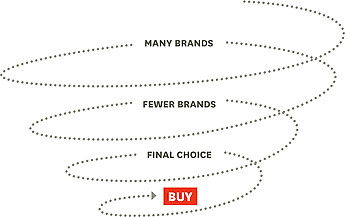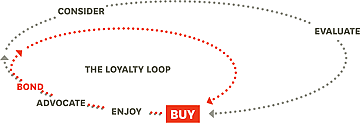
Yesterday, I blogged about the “Valid Metrics Framework” from the AMEC that provides a suggested guide post for selecting the right metrics to measure social media in the context of an integrated communications campaign. The framework uses actions and results across a continuum that based on the marketing funnel or AIDA framework. The stages include: awareness, understanding, interest/consideration, support/preferences, and action. In the discussion in the blog comments, there was a question about whether a linear framework is the best choice and a reference to “The Consumer Decision Journey”
The traditional marketing metaphor for many years has been a Funnel. It assumes that consumers start with a large number of products or brands in mind and methodically limit their choices until they’ve decided which one to purchase. After purchase, their relationship is focused on using the product.
Scaffolding by depth of relationship is a familiar framework for many nonprofits – whether it is donors or activists using the “Ladder of Engagement.” It has been applied to specific social media channels – for example Twitter Ladder or Facebook Ladder or to describes different levels of engagement across channels. Colleagues Sean Power and Alistair Croll have a funnel and analytics to measure online community engagement called “Communilytics. ” These frameworks show the process for becoming an activist or donor as linear one – going from name recognition to advocate.
But we know the media landscape has changed dramatically over the past decade and now we’re faced with so many choices and too much information as Steve Rubel points out in this presentation. What he is talking about is “transmedia storytelling” a term coined by Henry Jenkins. There are others that have looked at this: Gary Hayes Transmedia Storytelling model or Lini Srivastava’s Transmedia Activism model. Rubel describes the new the media landscape with four distinct areas: traditional media, “Tradigital” media (blogs), Owned Media (brand website), and Social Media/Networks (Facebooks, Twitter which are increasing being consumed on the go), although consumers do not make a distinction.
Is the marketing funnel the right metaphor in age of information overload and a cluttered media landscape?

I was intrigued to see this visual – showing the different loops. In the Networked Nonprofit, we have a chapter called “Learning Loops” that attempted to illustrate a less linear process. New research shows that rather than systematically narrowing their choices, consumers add and subtract brands from a group under consideration during an extended evaluation phase. After purchase, they often enter into an open-ended relationship with the brand, sharing their experience with it online.
This may not change what you measure or using a grid – but it certainly has implications for your strategy and tactics – especially around engagement and content – but how nonprofits build and maintain relationships with donors.
Is your strategy and measurement for integrated communications campaigns based on the right metaphor?
Beth Kanter is a consultant, author, influencer. virtual trainer & nonprofit innovator in digital transformation & workplace wellbeing.
